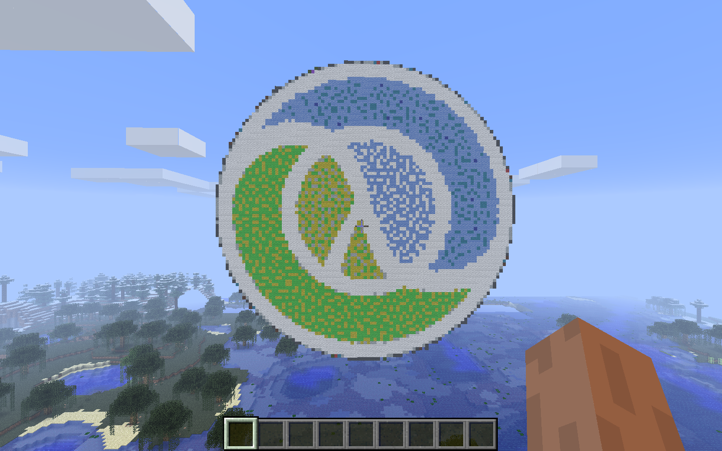Redstone
A Clojure interface to Minecraft: Pi Edition.
Installation
Add the following dependency to your project.clj file:
[redstone "0.1.4"]Usage
(require '[redstone.client :as mc])
(def server
{:host "localhost"
:port 4711})
(mc/send-message! server "Hello Minecraft")Examples
Minecraft: Pi Edition supports a handful of commands for querying and updating the player's position and blocks in the world.
Positions are maps of x, y, z coordinates.
user=> (mc/player-position server)
{:x 120.767 :y 44.252 :z 25.235}
user=> (mc/player-tile-position server)
{:x 121 :y 44 :z 25}Blocks types are represented by maps of id and data.
;; Get the block the player is standing on
user=> (let [player-position (mc/player-tile-position server)
position-under-player (update-in player-position [:y] dec)]
(-> server
(mc/block-at position-under-player))
{:data 0 :id 2}If you already know the block id of the block you want to place you can use its id and data values directly. Alternatively you can provide the block's name as a symbol. A complete list of available block types is here.
user=> (def position {:x 25 :y 55 :z 22})
#'user/position
user=> (mc/set-block-at! server position {:id 4 :data 0})
nil
;; ...is equivalent to
user=> (mc/set-block-at! server position :cobblestone)
nil
;; Block names are kebab-case...
user=> (mc/set-block-at! server position :red-flower)
nil
;; ...with optional data values (:red-flower:4 is a Tulip)
user=> (mc/set-block-at! server position :red-flower:4)
nilIn addition to standard block names, convenience names are also provided for coloured wool blocks.
user=> (mc/set-block-at! server position :orange-wool)
nil
;; ...where the block type is one of
;; {:white|:orange|:magenta|:light-blue|:yellow|:lime|:pink|:gray|:light-gray|:cyan|:purple|:blue|:brown|:green|:red|:black}-woolEvents
You can set up event listeners by calling listen! with an event and handler function. The handler function will be called with the server and event data each time the event occurs.
user=> (defn event-handler [server event]
(prn event))
#'user/event-handler
user=> (mc/listen! server :block:hit event-handler)
nil
;; Hit a block with a sword
{:event :block:hit, :position {:x 1, :y 2, :z 3}, :face 4, :player-id 10}
user=> (defn midas-touch [server event]
(mc/set-block-at! server (:position event) :gold-block))
#'user/midas-touch
;; Turn everything to gold!
user=> (mc/listen! server :block:hit midas-touch)
nil:block:hit is the only event currently emitted.
More Examples
For inspiration check out the Minecraft Sketchpad repository.
No Raspberry Pi?
Even you don't have a Raspberry Pi you can still run a version of the game which supports the Pi Edition API.
This involves:
- Running a Craftbukkit server
- Installing the RaspberryJuice plugin to emulate Pi support
Comprehensive instructions for setting up a Craftbukkit server with RaspberryJuice are available here.
License
Copyright © 2014 Henry Garner
Distributed under the Eclipse Public License version 1.0
